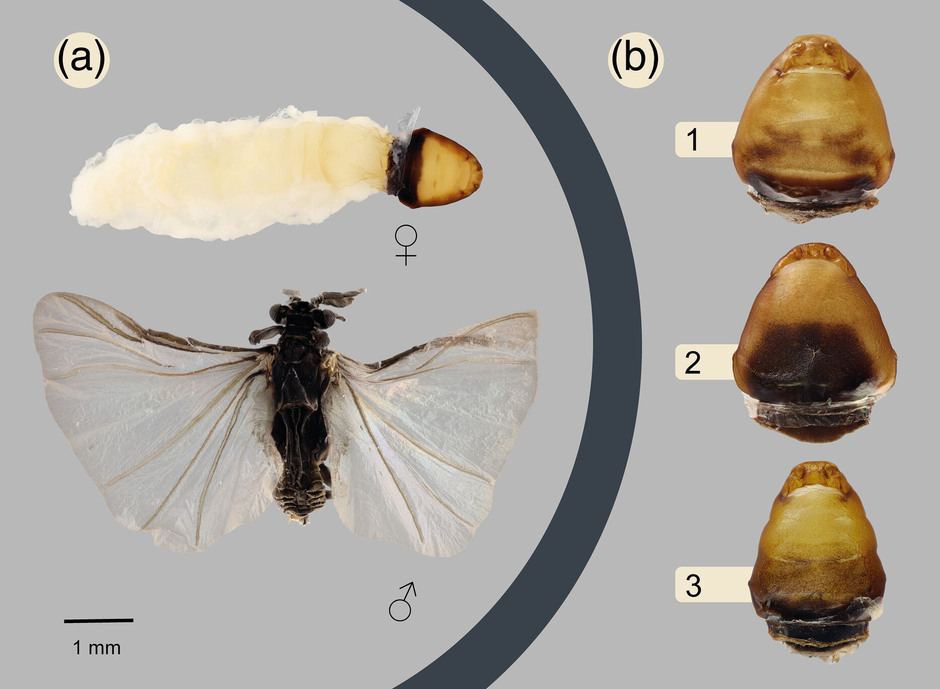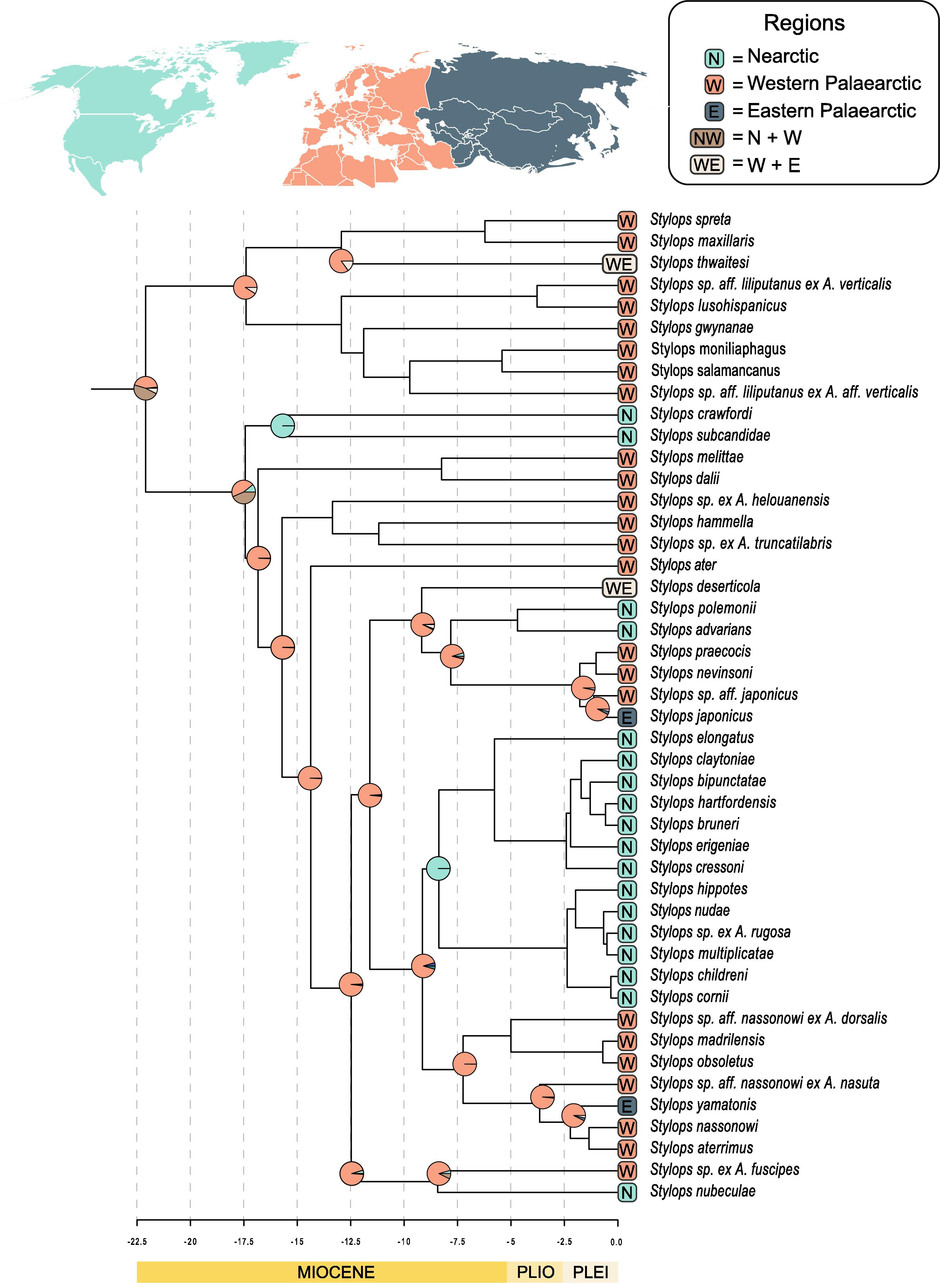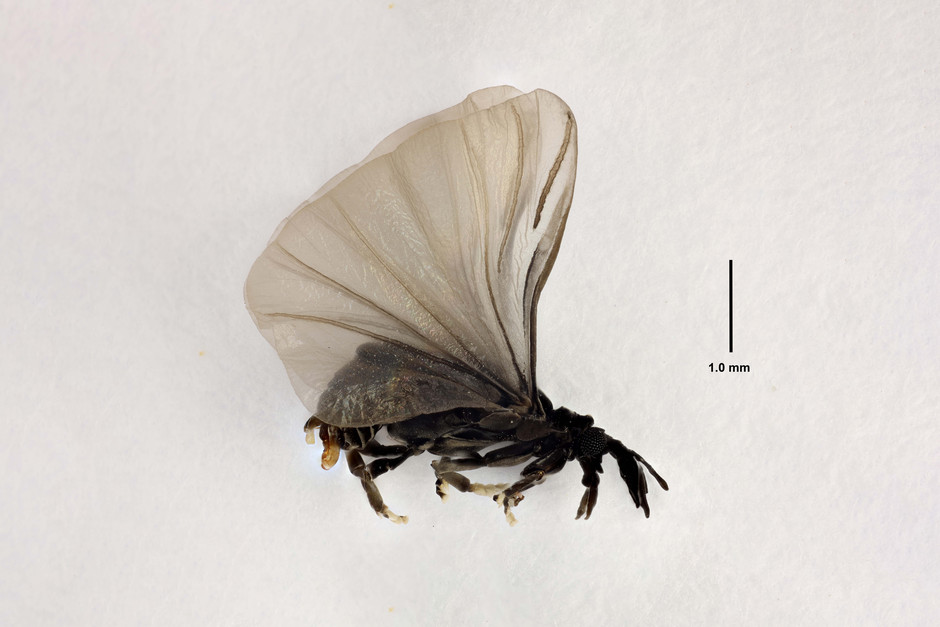Forskningsområden: Zoologi
Forskningsämnen: Biodiversitet, Taxonomi & artbeskrivning, Insekter
Project description
Project period: 2019-ongoing
Participating departments from the museum: Zoology, Bioinformatics and genetics
In this project, we explore the diversity of twisted-winged parasites in the Nordic region and analyze relationships, speciation, evolution and species boundaries on the northern hemisphere within the genus Stylops. We are also interested in Strepsiptera genomics with a reference genome of Stylops ater in the pipeline.
Background and purpose
Twisted-winged parasites is a peculiar and poorly understood group of insects. They spend most of their lives inside the bodies of other insects. The female never leaves the host and resembles a larva, while the male can fly but only lives for a few hours. Because males are rarely collected, and females have greatly reduced anatomy, studying their diversity has been challenging. The greatest difficulties lie within the largest genus of twisted-winged parasites, Stylops, which parasitizes wild mining bees (Andrena). Assumptions have rested on the identity of the host insects and various theories of host specificity. Hypotheses have ranged from "super-generalist" to "strict host-specificity"; is there one or over 50 different species in Europe? With today's DNA sequencing technology, we have obtained a new tool to answer this question.

The extraordinary sexual dimorphism in Strepsiptera. The adult male is a winged insect with legs, eyes and antennae while the adult female is larviform and never leaves the host. From Lähteenaro et al 2024a [https://resjournals.onlinelibrary.wiley.com/doi/10.1111/syen.12618]
Museum collections come into use
In large part, we have relied on existing museum collections in the Nordic countries of the hosts of the parasite, mining bees. In these collections, we find the twisted-winged parasite protruding between the segments of the bee's abdomen. We dissect the female twisted-winged parasite from the bee's abdomen and then take the sample to the DNA lab. With today's advanced DNA sequencing techniques, it is often possible to use museum specimens collected throughout the 20th century or even older. In this way, museum collections have tremendous value as a resource for research (#Museomics)!
Citizen Science
We have also engaged the public, especially interested amateur entomologists through social media channels, to help us collect fresh material of twisted-winged parasites.
Species diversity & host specificity
With data on the genetic material of parasites from many different host species, we have been able to test where species boundaries lie and thus answer the question of how host-specific twisted-winged parasites are in their choice of hosts. It turns out that they are neither super-generalists nor strictly host-specific in their choice of hosts; each species of twisted-winged parasite has a small number of closely related mining bee species as potential hosts. This means that we are expanding the known Swedish and Nordic species list from 1 to approximately 10 different Stylops species, and in Europe, there are at least thirty different species.
Evolution, biogeography and speciation
We are also studying relationships and the evolutionary history of Stylops across the entire northern hemisphere as well as mode of speciation. The biogeographic origin is still uncertain but we can see that there has been a limited number of Palearctic to Nearctic dispersal events during the evolutionary history of Stylops. Using coevolutionary analyses it is clear that the diversification of Stylops has been shaped by both host-coevolution and host switching. We use population genetic methods to further gain insights into the mode of speciation.

Dated phylogeny and reconstructed ancestral distributions for the genus Stylops in the Northern Hemisphere. From Lähteenaro et al 2024b [https://www.sciencedirect.com/science/article/pii/S1055790324000605?via%3Dihub].
Genomics
We collaborate with a large European project called ERGA (European Reference Genome Atlas External link.) with significant support from both Swedish SciLifeLab
External link.) with significant support from both Swedish SciLifeLab External link. and ERGA, working to develop a reference genome for the twisted-winged parasite species Stylops ater. A reference genome is an important research resource and consists of a representative's entire genetic material sequenced and assembled to a very high quality and complete level, divided into chromosomes with all genes identified. It turns out Stylops ater has a very small genome and there are likely fascinating genomic discoveries to be made related to the parasitic lifestyle and sexual dimorphism.
External link. and ERGA, working to develop a reference genome for the twisted-winged parasite species Stylops ater. A reference genome is an important research resource and consists of a representative's entire genetic material sequenced and assembled to a very high quality and complete level, divided into chromosomes with all genes identified. It turns out Stylops ater has a very small genome and there are likely fascinating genomic discoveries to be made related to the parasitic lifestyle and sexual dimorphism.
Publications
Lähteenaro M, Benda D, Straka J, Nylander JAA, Bergsten J (2024) Phylogenomic analysis of Stylops reveals the evolutionary history of a Holarctic Strepsiptera radiation parasitizing wild bees. Molecular Phylogenetics and Evolution 195 https://doi.org/10.1016/j.ympev.2024.108068 External link.
External link.
Lähteenaro M, Straka J, Forshage M, Hovmöller R, Nakase Y, Nilsson AL, Smith JT, Nylander JAA, Bergsten J. (2024) Phylogenomic species delimitation of the twisted-winged parasite genus Stylops (Strepsiptera). Systematic Entomology 49, 294-313. https://doi.org/10.1111/syen.12618 External link.
External link.
Pressrelease in Swedish: Zombiefierande parasiter mer specialiserade än man trott External link.
External link.
Mc Cartney AM, Formenti G, Mouton A, de Panis D, Marins LS, Leitão HG, Diedericks G, Kirangwa J, Morselli M, Salces-Ortiz J, Escudero N, Iannucci A, Natali C, Svardal H, Fernández R, De Pooter T, Joris G, Strazisar M, Wood J, Herron KE, Seehausen O, Watts PC, Shaw F, Davey RP, Minotto A, Fernández JM, Böhne A, Alegria C, Alioto T, Alves PC, Amorim IR, Aury J-M, Backstrom N, Baldrian P, Baltrunaite L, Barta E, Bed’Hom B, Belser C, Bergsten J ... Lähteenaro M... et al. (2024) The European Reference Genome Atlas: piloting a decentralised approach to equitable biodiversity genomics. Preprint bioRxiv https://doi.org/10.1101/2023.09.25.559365 External link.
External link.
Funding
Project team
External contributors
The project group includes members from the universities in Uppsala and Prague.
Project manager

Project member



